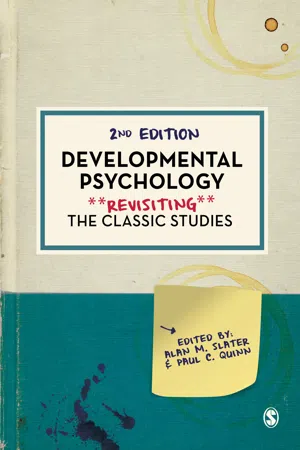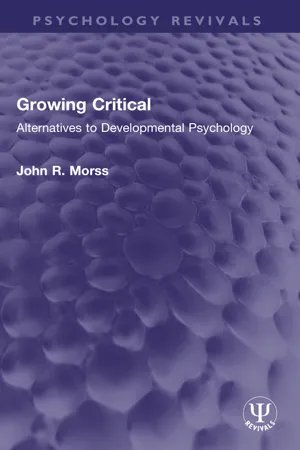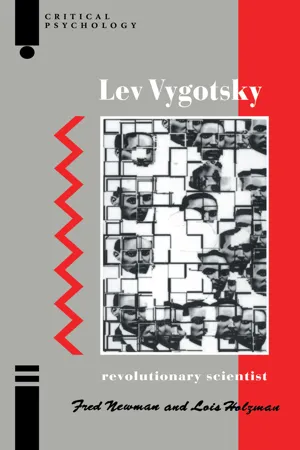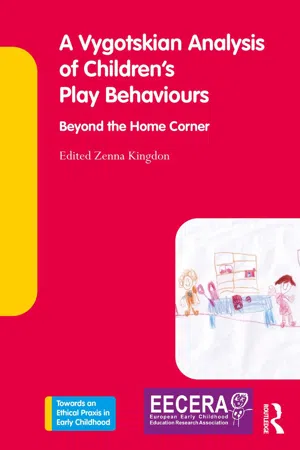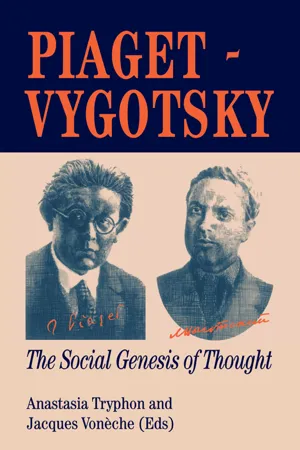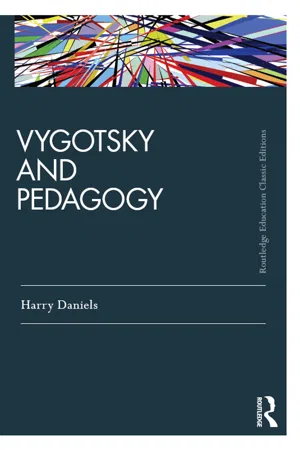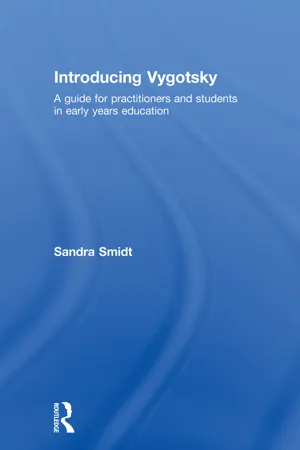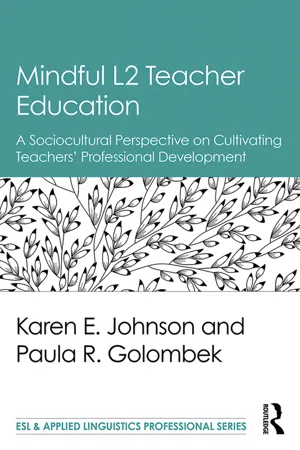Psychology
Lev Vygotsky
Lev Vygotsky was a pioneering psychologist known for his sociocultural theory of cognitive development. He emphasized the role of social interaction and cultural influences in shaping a child's learning and development. Vygotsky's work has had a significant impact on educational practices and has influenced our understanding of how children acquire knowledge and skills.
Written by Perlego with AI-assistance
Related key terms
Related key terms
1 of 4
Related key terms
1 of 3
12 Key excerpts on "Lev Vygotsky"
- eBook - ePub
Developmental Psychology
Revisiting the Classic Studies
- Alan M Slater, Paul C Quinn, Alan M Slater, Paul C Quinn(Authors)
- 2020(Publication Date)
- SAGE Publications Ltd(Publisher)
Despite having been written nearly a century ago, Vygotsky’s critique of other theoretical views about learning and development and the ideas he introduces in this paper are relevant today. When his ideas became known, his perspective about the culturally organized and socially mediated nature of learning and intellectual development was not previously available in developmental science (Schaffer, 2006). His view overcomes some of the limitations of approaches that focus on cognitive development as determined solely by mechanisms inside the individual. It is true that Vygotsky’s assertion that development occurs at the “child-society border” has been difficult for some Western-trained scientists to understand after years of doing research aimed at separating the individual child and the external world (Kessen, 1979). Yet Vygotsky’s view has been useful in helping to direct the attention of researchers to the social and cultural origins of thinking along with the historical-cultural context of intellectual growth. These ideas are relevant to studying many of the concerns raised in today’s world.Vygotsky’s ideas about learning and development have also increased awareness of the role of the immediate social context in learning and cognitive development, and challenged developmental researchers to explore the role of context in greater depth. His emphasis on collaborative problem solving with more skilled partners has been influential in the learning sciences (Göncü & Gauvain, 2012; Sawyer, 2014) and developmental researchers have demonstrated the value of this approach in studies of children’s learning in many areas of cognition including attention, memory, problem-solving skills, and planning (Gauvain, 2001). This research shows that children’s understanding and cognitive skills can indeed be improved when adults or more skilled peers provide them with appropriate support for learning. His notion of the zone of proximal development, in particular, has given rise to several important concepts such as scaffolding (Wood, Bruner, & Ross, 1976) and guided participation (Rogoff, 1990). In addition, it coincides with the growing interest in microgenetic change that occurs over a learning experience (National Academies of Sciences, Engineering, and Medicine, 2018; Siegler, 2006). Vygotsky’s ideas are also relevant to studying child development during cultural change, a topic that is garnering significant interest during this period of rapid societal change in the context of globalization (Gauvain & Munroe, 2018). - eBook - ePub
Growing Critical
Alternatives to Developmental Psychology
- John R. Morss(Author)
- 2023(Publication Date)
- Routledge(Publisher)
Kozulin 1990 ).Soviet psychology had inherited various institutions and research programmes from the pre-Revolutionary years. There were several competing methodologies, including versions of the conditioning psychology developed earlier by Pavlov, and versions of behaviourist psychology. Vygotsky was one of a number of young scholars whose views came to be influential in the debate as to likely directions for a Soviet psychology in the 1920s. Later, he sketched out a psychology in which many aspects of development would be treated as the taking-in of a culture. Vygotsky thereby offered a sociohistorical framework for the study of human development, in which the larger cultural values of a society would be taken to define maturity in that society. For Vygotsky, human development involves the ‘interiorization’ of a culture and hence in large part, what others have called the social construction of mind (Harré 1986 ). At the same time, he insisted on the significance of biology and evolution in the form of a natural line of development intertwining with the cultural line.In its opposition to a more traditionally biological theory, and especially in its optimism for human change under changed circumstances, Vygotsky’s approach fitted in with the prevailing political style. More specifically, Vygotsky argued that thinking and consciousness can be treated as a kind of problem-solving. If so, thinking would be a covert kind of labour, because labour in general involves the individual interacting with the world in a purposeful way. Moreover, the specific tasks (physical or mental) which a person is called upon to undertake are determined by the cultural setting – in all its economic and historical detail. This interpretation agreed, at least in general terms, with some of the claims of Marx and of Engels. Marx had emphasized the way in which people interact with the environment through work, transforming both nature and themselves in this ‘dialectical’ process. Engels had derived from Marx a set of philosophical doctrines, massively influential in early Soviet thinking, that attempted to codify this dialectical approach to human beings. - eBook - ePub
Lev Vygotsky
Revolutionary Scientist
- Lois Holzman, Fred Newman(Authors)
- 2023(Publication Date)
- Routledge(Publisher)
Chapter 1 Vygotsky and psychology A debate within a debate
DOI: 10.4324/9781003419501-2By all accounts, Lev Vygotsky was a brilliant and charismatic thinker, speaker, mentor and builder. He is credited by some with breaking through the stalemate in the debates within Russian and European academic circles about what was the proper object of psychological study, thus influencing the historical course of psychology as a human science from the 1920s up to the present and, in the process, giving birth to what can be properly identified as a Soviet psychology.1Born in 1896 (the same year as Jean Piaget), as an adolescent Vygotsky was passionately interested in philosophy, literature and culture. He was a brilliant student who, as a Jew in anti-Semitic czarist Russia, was limited in the fields of study and professions open to him. Nevertheless, he managed to complete a law degree, write a dissertation on the psychology of art, teach and publish literary works before turning his attention and creativity to fundamental questions of human development and learning.Although he contracted tuberculosis at the age of 24 and was sickly throughout his short life of thirty-seven years, Vygotsky became the leading Marxist theoretician among the post-revolutionary Soviet psychologists. He formulated one of his primary concerns in this way: 'What new forms of activity were responsible for establishing labor as the fundamental means of relating humans to nature and what are the psychological consequences of these forms of activity?' (1978, p. 19). Even passing familiarity with traditional developmental psychology texts is enough for this question to strike the reader as radical: Vygotsky is talking about activity, not behavior or personality or traits; he claims that human activity (as yet unspecified) produced a specific human activity, namely labor, as the fundamental organization of the relationship between human beings and nature, and that there are psychological consequences of these forms of activity. This question and the premises underlying it are steeped in the Marxian world view, dialectical historical materialism.2 - eBook - ePub
A Vygotskian Analysis of Children's Play Behaviours
Beyond the Home Corner
- Zenna Kingdon, Zenna Kingdon(Authors)
- 2020(Publication Date)
- Routledge(Publisher)
Vygotsky is concerned with the ways in which learners make progress, focussing on process as well as product in assessment (Daniels 2001). He puts the child at the centre of the learning process, seeing the child as an active constructor of knowledge. Vygotsky considers play to be central to child development. Vygotsky posited that it was as a direct result of the child’s interactions with more knowledgeable others and social interactions with members of his community that the child developed the necessary apparatus for thinking and learning (Smith et al. 2003:493). Vygotsky stressed that learning took place within the specific culture in which the child existed clearly demonstrating that cognitive development does not occur in isolation but as an aspect of socio-cognitive context. A central tenet of his work was concerned the Zone of Proximal Development, something that a child can do today with support but tomorrow may be able to complete unassisted (Vygotsky 1978).Vygotsky’s work is marked by three distinct phases and conceptual shifts (Daniels 2001, Minick 2005). The first phase of Vygotsky’s research took place between 1925 and 1930. During this phase, he concentrated on an analytical unit which he refers to as the instrumental act. In this phase, stimulus-response was the foundation for learning and behaviour in humans and animals. He argues that speech gave humans an exclusive form of stimuli to control their behaviour; it is a mechanism common to both social behaviour and psychological processes, whilst being unique to humans (Minick 2005). During the second phase from 1930 to 1932, his focus moves to psychological systems, arguing that psychological research must focus not on the development of new mental functions but on the relationships between them and the development of psychological systems (Minick 2005). These psychological processes are known as higher mental functions and included voluntary attention, voluntary memory, and rational, volitional, goal-directed thought (Minick 2005). The last 2 years of Vygotsky’s life were marked by his greater and greater emphasis on the analysis of the development of psychological systems and their relationship with social behaviour (Daniels 2001). The significance of Vygotsky’s contributions to social theory is his study of general and meta-theory that underpins psychological phenomena (Daniels 2001). In 1932, Vygotsky delivered a series of lectures in Leningrad, which he later published as Thinking and Speech in 1934 (Minick 2005). In 1932, he also completed a critique of Piaget’s work on children’s egocentric speech (Minick 2005). Vygotsky recognises that psychology owes much to the work of Piaget. He believes that it is no exaggeration to say that Piaget revolutionised research concerning children’s thought and speech. In his text Thought and Language - eBook - ePub
Piaget Vygotsky
The Social Genesis Of Thought
- Anastasia Tryphon, Jacques Vonèche, ANASTASIA TRYPHON, Jacques Vonèche(Authors)
- 2013(Publication Date)
- Psychology Press(Publisher)
CHAPTER NINE Social interaction and individual understanding in a community of learners: The influence of Piaget and Vygotsky Ann L. Brown University of California, Berkeley, USA Kathleen E. Metz University of California, Riverside, USA Joseph C. Campione University of California, Berkeley, USA The importance of social interaction as a major force in cognitive development has become associated in America with Vygotskyan theory. In contrast, Piagetian theory has been seen as influential in mapping individual cognitive growth. However the two theorists have more in common than is usually supposed. Vygotsky’s central interest was in the evolution of cognitive processes, in growth and change rather than static state cognition. It is therefore not surprising that Vygotsky had a special interest in children’s learning, where one can observe cognitive processes “undergoing change right before one’s eyes.” 1 For Vygotsky, developmental analysis was central to psychological investigation in general, not just a peripheral offshoot having to do with the specialised study of children. If Vygotsky was more interested in individual cognitive development than is usually thought, Piaget was not immune to the role of social experiences. In particular, Piaget regarded peer interaction as an ideal forum for helping children “decentre” their thinking from one particular egocentric view in order to consider multiple perspectives. Faced with a group of peers who not only fail to accept his or her views but hold opposing opinions, the child must compromise. In the process of compromising, the group produces a solution that is more mature than each individual effort - eBook - ePub
- Fred Newman, Lois Holzman(Authors)
- 2005(Publication Date)
- Routledge(Publisher)
Chapter 1 Vygotsky and psychology A debate within a debateBy all accounts, Lev Vygotsky was a brilliant and charismatic thinker, speaker, mentor and builder. He is credited by some with breaking through the stalemate in the debates within Russian and European academic circles about what was the proper object of psychological study, thus influencing the historical course of psychology as a human science from the 1920s up to the present and, in the process, giving birth to what can be properly identified as a Soviet psychology.1Born in 1896 (the same year as Jean Piaget), as an adolescent Vygotsky was passionately interested in philosophy, literature and culture. He was a brilliant student who, as a Jew in anti-Semitic czarist Russia, was limited in the fields of study and professions open to him. Nevertheless, he managed to complete a law degree, write a dissertation on the psychology of art, teach and publish literary works before turning his attention and creativity to fundamental questions of human development and learning.Although he contracted tuberculosis at the age of 24 and was sickly throughout his short life of thirty-seven years, Vygotsky became the leading Marxist theoretician among the post-revolutionary Soviet psychologists. He formulated one of his primary concerns in this way: ‘What new forms of activity were responsible for establishing labor as the fundamental means of relating humans to nature and what are the psychological consequences of these forms of activity?’ (1978, p. 19). Even passing familiarity with traditional developmental psychology texts is enough for this question to strike the reader as radical: Vygotsky is talking about activity, not behavior or personality or traits; he claims that human activity (as yet unspecified) produced a specific human activity, namely labor, as the fundamental organization of the relationship between human beings and nature, and that there are psychological consequences of these forms of activity. This question and the premises underlying it are steeped in the Marxian world view, dialectical historical materialism.2 - eBook - ePub
Catching Readers Before They Fall
Supporting Readers Who Struggle, K-4
- Pat Johnson, Katie Keier(Authors)
- 2023(Publication Date)
- Routledge(Publisher)
We believe that Vygotsky’s theory is important and applicable enough to warrant its own chapter. Over the past five years or so, we, and many of the teachers we work with, have delved deeper into Vygotsky’s work and layered our thinking. Through conversations with colleagues and our work with struggling readers, we now have a better grasp of terms such as zone of actual development, zone of proximal development, and social speech, private speech, and inner speech. This understanding has caused a slight shift in our teaching and impacts the way we plan, instruct, and use language with struggling readers. In this chapter we will be sharing those understandings.As you read in this chapter the examples of teachers and students working together, we hope you will reflect on the following questions:- What is Vygotsky’s theory and why should I take time to learn about it?
- When is my teaching most effective?
- How do children learn best?
- What is the zone of proximal development (ZPD)?
- What does the gradual release of responsibility model have to do with ZPD?
- How will understanding ZPD make me a better teacher of reading?
- What are the benefits for struggling readers?
What Are the Basics of Vygotskian Theory?
Lev Vygotsky was born in Russia in 1896 and died of tuberculosis in 1934 at the age of 37. In his short lifetime he published 180 works, with unpublished manuscripts totaling 300. His works were banned by Stalin and were not allowed to be read and circulated until after Stalin’s death in 1953. Americans were slow to accept his theories because of the popularity of Piaget’s work and behaviorist theories. More detailed information on Vygotsky’s life and work can be found in Scaffolding Children’s Learning: Vygotsky and Early Childhood Education by Berk and Winsler (1995 ).In the last twenty years or so, Vygotsky’s theories of how children learn have found their way into nearly every college curriculum for teacher training. Listed below are three major ideas about which he wrote extensively (Vygotsky 1978 , 1986 - eBook - ePub
- Harry Daniels(Author)
- 2016(Publication Date)
- Routledge(Publisher)
The maturation of the child’s higher mental functions occurs in this co-operative process, that is, it occurs through the adult’s assistance and participation. In the domain of interest to us, this is expressed in the growth of the relativeness of causal thinking and in the development of a certain degree of voluntary control in scientific thinking. This element of voluntary control is a product of the instructional process itself…. In a problem involving scientific concepts, he must be able to do in collaboration with the teacher something that he has never done spontaneously … we know that the child can do more in collaboration that he can independently. (Vygotsky, 1987, pp. 168, 169, 216) The zone of proximal development Schneuwly (1994) discussed Vygotsky’s theory of development in terms of the individual’s reorganisation of lower psychological functions to form new higher ones whilst emphasising that psychological functions are themselves historical-cultural constructions. He viewed the concept of zone of proximal development (ZPD) as the theoretical attempt to understand the operation of contradiction between internal possibilities and external needs that constitutes the driving force of development. The concept of ZPD was created by Vygotsky as a metaphor to assist in explaining the way in which social and participatory learning takes place (John-Steiner and Mahn, 1996). The general genetic law of cultural development asserts the primacy of the social in development. I have sought to emphasise that Vygotsky was concerned to develop an account in which humans were seen as ‘making themselves from the outside’. Through acting on things in the world they engage with the meanings that those things assumed within social activity. Humans both shape those meanings and are shaped by them. This process takes place within the ZPD. This well-known concept is often cited as Vygotsky’s most profound contribution to educational debate - eBook - ePub
Introducing Vygotsky
A Guide for Practitioners and Students in Early Years Education
- Sandra Smidt(Author)
- 2013(Publication Date)
- Routledge(Publisher)
Here we have three children sharing a book (a cultural tool) and using it as the starting point for having a discussion. Mehmet, in a sense, is the ‘expert’ in this session, because the celebration they are looking at is a Turkish one, so the cultural tools and associations are familiar to him. But you can see how Daniel tries to understand the meaning of the steps on which the coffin was placed in terms of his own religious and cultural experience, by suggesting that Mehmet’s grandfather might have ‘risen to heaven’. Presumably he was thinking of Christianity and the resurrection.Think about your class or setting and consider whether you offer the following:- a range of resources which reflect the cultures and languages and experiences of the children in your group;
- opportunities for sharing, collaboration and participation;
- opportunities for the child to be heard and taken seriously;
- opportunities for peer teaching where one child, as the expert, shares knowledge, understanding and experience with others.
Language and concepts: the zone of proximal development
One of the things that should be apparent to you, by now, is the impossibility of discussing one of Vygotsky’s ideas without referring to others. We have talked about concepts in the previous section where we related concepts to memory, and to internalisation and to mediation. You will find references to language as a cultural tool in almost everything Vygotsky wrote. Now we will try to draw some of these threads together as we consider one of Vygotsky’s most important contributions to pedagogy . It is something you are almost certain to have heard of – the zone of proximal development or the ZPD (sometimes referred to as the ZoPeD).In essence Vygotsky was interested in observing and analysing how children make progress. We have talked about how they move from everyday concepts to scientific concepts, from using cultural tools to enable and enhance memory and then using internalised memory for solving problems. One of the things Vygotsky noted in his last account of the ZPD (to be found in his final work Thinking and Speech, 1987[1934]) was that development and instruction (or teaching) do not coincide. Teaching is only of any benefit to the learner when it moves ahead of development - eBook - ePub
- Irving B. Weiner, William M. Reynolds, Gloria E. Miller(Authors)
- 2012(Publication Date)
- Wiley(Publisher)
James Lantolf has played a central role in developing a sociocultural approach to the study of second-language acquisition (SLA) and second-language teaching/learning. He and his students and colleagues have developed a methodological approach to researching second-language acquisition based on the work of Vygotsky using mediation; inner speech, private speech, and internalization; the regulatory function of language; the zone of proximal development and scaffolding; testing, including dynamic assessment. (Lantolf, 2000; Lantolf & Appel, 1994; Lantolf & Poehner, 2008; Lantolf & Thorne, 2006). Lantolf and Beckett (2009) reviewed sociocultural research investigating SLA from 1985 to the present. Mahn (2013) similarly describes aspects of Vygotsky's methodology and theory that have guided sociocultural approaches to SLA research.Vygotsky's Influence on Literacy Research
In the same way that Vygotsky's work helped provide a sociocultural foundation for second-language research, it also provides a foundation for first language literacy studies. Writing theorists such as Emig (1971), Britton (1987), Langer and Applebee (1987), and Moffett (1981) constructed a new approach to literacy that relied on Vygotsky's key ideas. His influence has also been important in the development of reading theories by Clay (1991), Holdaway (1979), K. Goodman and Goodman (1990), and Taylor (1998). Among the topics explored by these literacy researchers are sociocultural considerations of the literacy socialization process (Panofsky, 1994).In the “Prehistory of Written Language,” Vygotsky (1978) examined the roles of gesture, play, and drawing in the socialization for literacy. He analyzed the developmental processes children go through before schooling as a foundation for literacy learning in school. He argued that gestures lay the groundwork for symbol use in writing: “The gesture is the initial visual sign that contains the child's future writing as an acorn contains a future oak. Gestures, it has been correctly said, are writing in the air, and written signs frequently are simply gestures that have been fixed” (Vygotsky, 1978, p. 107). In a study on parent-child book reading, Panofsky (1994) also emphasized the importance of connecting visual signs with verbal representations. She suggested that children need assistance in interpreting pictures in books, a process that contributes to the move from signs to representations. An example of such a move is a parent's saying, “See that tear? He is crying” (Panofsky, 1994, p. 232). Anne Dyson (1989), who has shown the importance of dramatic play, drawing, and writing in the development of child writers, also emphasized the multidimensionality of literacy. - eBook - ePub
Mindful L2 Teacher Education
A Sociocultural Perspective on Cultivating Teachers' Professional Development
- Karen E. Johnson, Paula R. Golombek(Authors)
- 2016(Publication Date)
- Routledge(Publisher)
obuchenie) and cognitive development. He was highly critical of traditional approaches to formal schooling, claiming thata straightforward learning of concepts always proves impossible and educationally fruitless. Usually, any teacher setting out on this road achieves nothing except a meaningless acquisition of words, mere verbalization in children, which is nothing more than simulation and imitation of corresponding concepts which, in reality, are concealing a vacuum. (p. 356)Instead, he postulated that the development of academic concepts in the mind of the child is substantially different from the development of everyday concepts, which arise spontaneously through concrete experiences in the everyday world. For Vygotsky, academic concepts in children undergo a fundamental process of development, that is, “when a child assimilates a concept, he reworks it and in the course of this reworking, he imprints it with certain specific features of his own thoughts” (p. 361). Thus, while their developmental processes are different, academic concepts and everyday concepts are “tightly bound up with one another and … constantly influence one another” (p. 365). For school aged children, Vygotsky argued that the key to internalization (from the social to the psychological) is the extent to which the processes of school teaching/learning (obuchenie) interrelate academic and everyday concepts in goal-directed, practical activity that has relevance in the material world (see also Robbins, 2003 ).We find Vygotsky’s (1987) obuchenie, defined as “teaching/learning as collaborative interactions governed by a mutuality of purpose” (p. 212), to be a useful lens through which to explore the dialogic interactions that emerge in the practices of L2 teacher education. Obuchenie captures the actions and intentions of teaching and learning, rather than only a teacher who provides instruction to a child who learns (van der Veer & Valsiner, 1991 ). Importantly, obuchenie places greater focus on the instructional side of expert/novice interactions, suggesting that obuchenie leads rather than follows cognitive development (Cole, 2009 ). This distinction is important because Vygotsky argued against the prevailing notion of his time that a child’s psychological functions must reach a certain level of maturity before instruction is beneficial. In fact, he argued that teaching/learning (obuchenie) and development are distinct processes but that obuchenie enables a series of developmental processes to undergo their own development. Therefore, obuchenie “is only effective when it points to the road for development” and while Vygotsky argued that it is the teacher “who creates conditions for certain cognitive processes to develop, it is the child who has to learn to transform an ability ‘in itself’ into an ability ‘for himself’” (van der Veer & Valsiner, 1991, p. 331). Obuchenie - eBook - ePub
Self-Regulated Learning and Academic Achievement
Theoretical Perspectives
- Barry J. Zimmerman, Dale H. Schunk, Barry J. Zimmerman, Dale H. Schunk(Authors)
- 2013(Publication Date)
- Routledge(Publisher)
goal ” (p. 22). Activity theory presumes that motives and goals emerge and exist within the sociocultural realm, rather than as a property of the individual, and that activity, actions, and operations are interdependent and cannot be analyzed in isolation; “Objects themselves can become energizers, goals, and tools only within a system of human activity. Out of the context of this system they lose their being as energizers, as goals, or as tools” (Leontiev, 1974–1975, p. 28–29).Wertsch (1985) maintained that the construct of activity applies “to the interpsychological as well as the intrapsychological plane, and it provides an appropriate framework for mediation” (p. 208). Like Vygotsky and Leontiev, many contemporary theorists (e.g., Lave, 1988; Rogoff, 1990) presume that cognitive activity is so context bound that one can never distinguish between the individual’s cognitive ability, the individual’s affective state, the context in which activity takes place, and the activity itself. Rogoff (1990) argued that while “events and activities are organized according to goals…mental processes cannot be dissected apart from the goals to be accomplished and the practical and interpersonal actions used” and that “meaning and purpose are central to the definition of all aspects of events or activities and cannot be separated by summing the features of the individual and the features of the context” (p. 29). From this perspective, constructs such as motivation cannot be distinguished from the larger realm of activity, and the individual’s activity cannot be distinguished from the larger sociocultural context. One can only study the larger sphere of human activity—in Leontiev’s words, “laying bare [activity’s] inner relations” (p. 28). Easier said than done.Research within a Vygotskian tradition may well involve multiple methods, emergent constructs, and evolving questions. Work related to self-regulated learning, for example, includes group and task comparisons and case study designs. Conceptions of self-directive behavior have emerged as identity activity, and questions of how to predict SRL have evolved into questions of how to promote it through authentic relationships with students that are characterized by challenging support and contingent feedback. The ultimate goal of research in this tradition remains constant, however. SRL is instrumental to socially meaningful activity; SRL not only empowers the individual, it enriches the culture. Even so, there is much to learn from the wealth of SRL research in other traditions and constructs in related areas of study (e.g., attribution theory, parenting styles). The model of co-regulated learning presented next is one attempt to illustrate this utility.
Index pages curate the most relevant extracts from our library of academic textbooks. They’ve been created using an in-house natural language model (NLM), each adding context and meaning to key research topics.
Explore more topic indexes
Explore more topic indexes
1 of 6
Explore more topic indexes
1 of 4
